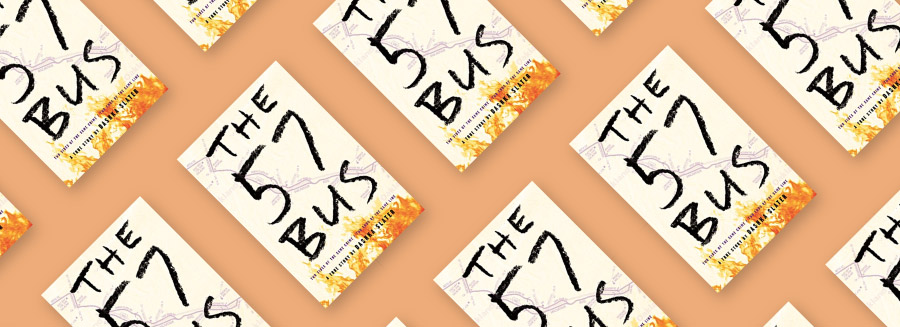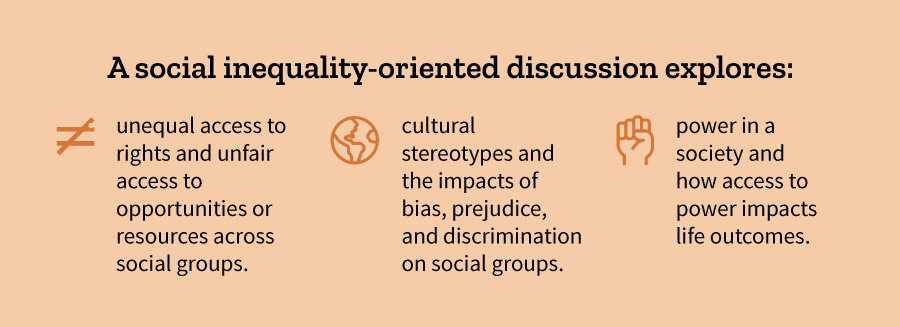
This is the third post in the “Complex Books, In Context” series. Check out the first two resource guides for Wonder by R.J. Palacio and Genesis Begins Again by Alicia D. Williams.
In our quest to provide diverse and inclusive texts to our students, we must also be intentional about how we use texts that address social inequality issues. If we use our lessons to only focus on the characters or the craft, we miss an important opportunity to help them understand the world around them. When we lean into the complexity of a book, young people can begin to develop skills for learning about all kinds of complicated realities. We cannot prepare our students to actively engage in complex conversations if we avoid the tough stuff in our classrooms. Students, like everyone else, need to practice this skill. One clear way we can support them is by helping them learn to see the social context surrounding a story, whether that story is in a picture book or YA novel. To “zoom out” on any text, ask the following questions and collect resources on the historical, political, and cultural contexts. (Some of the resources you collect can be for students, but some can just be for you and your colleagues, to provide some grounding for the discussion and prepare for questions students may ask.)
- What background information is important to know about in order for us to really understand what’s going on in this story? (terms, concepts, historical events, statistics)
- Are there laws or policies relevant to this story that we should know about? Are there social movements that have focused on the issues in this story?
- What cultural beliefs (ideas, norms, stereotypes) should we be familiar with in order to truly understand the story?
Today, I’m zooming out on The 57 Bus–a nonfiction narrative accounting, written by journalist Dashka Slater. It is an excellent example of a book that provides the opportunity for students to get comfortable with complexity, by allowing them to empathize with multiple unique perspectives at one time. The story follows the aftermath of an attack on Sasha (a white agender teenager) by Richard (a black male teenager) on a bus in Oakland, California. It explores gender and sexuality diversity, the threat of violence LGBTQ people face for simply existing in public space, and racial injustices in the criminal justice system. It allows students to go beyond the news coverage of such an event and come away with a deep understanding of both young people involved as they navigate the long-term effects of this horrible day. If we zoom out on these themes, we can create conditions for our students to discover how our racial, class, and gender identities intersect to influence our life experiences and opportunities.
Historical, Political, and Cultural Context
The following are examples of resources that allow educators to help students “zoom out” from Richard and Sasha’s story to the larger social context, to better guide conversations on social inequality.
Anti-Bias Education Glossary
ADL | Definitions
The following are examples of definitions you would collect to lay the groundwork for your students–to make sure everyone is speaking the same “language.”
Gender: The socially defined “rules” and roles for men and women in a society. The attitudes, customs, and values associated with gender are socially constructed. Dominant Western society generally defines gender as a binary system, but many cultures define gender as more fluid and existing along a continuum.
Intersectionality: The examination of overlapping and connected social systems that compound oppression for individuals who belong to multiple marginalized social groups based on their race, gender, class, gender identity, religion, sexual orientation, disability, etc.
Social Power: The capacity to control, access, and/or influence people, institutions, and resources.
Systemic Racism: A combination of systems, institutions, and factors that advantage white people; and for people of color, cause widespread harm and disadvantages in access and opportunity.
Criminal Justice Facts
The Sentencing Project | Interactive Website
This website provides a wealth of information for students to explore about incarceration in the United States, including state-by-state data and specific statistics on the juvenile justice system.
How We’re Priming Some Kids For College — And Others For Prison
Alice Goffman | TED Talk
In the United States, two institutions guide teenagers on the journey to adulthood: college and prison. Sociologist Alice Goffman spent six years in a low-income Philadelphia neighborhood and saw first-hand how African American and Latino teenagers are funneled down the path to prison.
A Short History of Trans People’s Long Fight For Equality | TED Talk
Samy Nour Younes | TED Talk
Samy Nour Younes shares the remarkable, centuries-old history of the trans community, filled with courageous stories, inspiring triumphs, and a fight for civil rights.
From Manly to Sexy: The History of the High Heel
Sociological Images | Blog
This blog post from sociologist Lisa Wade can help spark a class discussion about how gender norms change across time and place and shows there is nothing static or “natural” about gender expression.
Everyone Uses Singular ‘They,’ Whether They Realize It Or Not
NPR | Podcast
As genderqueer people are increasingly embracing the singular “they,” many argue it is grammatically incorrect. NPR linguist Geoff Nunberg breaks down the ongoing debate about “they” as a singular pronoun and makes the case for constantly evolving grammar rules.
Conversation Guide
The following examples of prompts offer guidance for educators who want to explore social inequality issues with students. The intention is to help educators consider these types of issues before talking with students.

- Gender is a social construct. But what does that mean exactly? And how can we help young people wrap their heads around this idea? The easiest way to introduce this concept is to look at how gendered norms change across time and culture. Have your students explore examples of how our ideas about femininity and masculinity change (high heels as masculine, computer programming as feminine, etc.) Ask your students to reflect on what gender “rules” or gendered expectations they break or want to break. Ask them to ponder who gets to decide what is considered the “correct” way to do femininity or masculinity. This process of unpacking is the first step to understanding gender as a social construct–not linked to biological sex. The other benefit is that we are including everyone in the idea of gender “rules” and rule-breaking. If you are a cisgender educator, make sure to be especially cognizant of not framing gender non-conforming people as different from “the rest of us.” Even with good intentions, that type of framing can quickly slip into “othering.”
- While new generations are increasingly accepting of diversity in gender expression, trans and genderqueer people still face significant oppression–at school, at work, in housing, and simply for existing in public space (as we see with Sasha’s experience). Students will recognize the unfairness of this situation, but we can help them go deeper. Ask them why they think gender nonconformity so offends some people (to the point that someone would inflict violence on someone else because of it). Why do we hold so closely to these “rules” and norms? What are the motivations for enforcing these “rules”? The idea here is to get them thinking about gender not only as an individual choice, but as a set of expectations built into the structure of society.
- Have students explore the data and statistics on The Sentencing Project’s interactive website. Richard’s story is not just Richard’s story. He is part of a larger system that treats boys of color fundamentally different from white boys. For example, to really understand the context for this story, you’d want your students to discover that Black youth were more than 5x as likely to be detained or committed compared to white youth, and in California, Black youth are 10x as likely to end up being held in juvenile facilities. Of course, what Richard did to Sasha was wrong, but we can’t examine his experience in the aftermath of that day outside of this larger social context. Ask your students to consider if they think Richard would have been treated the same in the criminal justice system had he been a white teenage boy from a wealthy community. Use this conversation to introduce the concept of intersectionality–Sasha is gender non-conforming, but also white and middle class. Richard is Black and comes from a family without the same economic resources as Sasha’s. These realities absolutely have an impact on the media narrative and outcome of the case. It’s not about minimizing what Richard did, it’s about helping students see that we don’t exist in a vacuum. Context matters.






